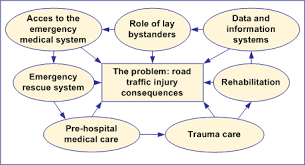
Death itself is a painful phenomenon but it is more painful to realise that these deaths could have been prevented, hence the need to enhancing effective post-crash care.
As much as no one wills or hopes to be victim of accidents, yet there are victims of different accidents and road traffic accidents daily.Traffic crashes are violent and unexpected happenings that affect the lives of thousands of people each day and leave many families feeling helpless especially when they cannot find the necessary support. In this situation, Health Emergency Initiative (HEI) functions as these victim’s NEXT OF KIN to help in the provision of support through swift provision of funds for the victims’ emergency medical treatment.
Every year on the roads of the world, 1.25 Million people die and 50 million people injured. 500 children die daily and reality hits more when two people die from a road crash every minute of the day (2016: Investing in Road Safety; A Global Imperative for the Private-Sector).The fore-mentioned research finding is a saddening one that necessitates the need for an effective post-crash care system.
Post-crash care involves provision of immediate attention and stabilization to emergency victims on crash sites, appropriate transportation with a medically equipped vehicle to a medical facility, medical trauma care capacity at the hospital, and rehabilitation services necessary to provide reintegration into active life.
Here are some tips to enhancing effective post-crash care:
- Improvement of Quality of Roads:Good roads can enable responders to travel to the scene more rapidly and victims of a crash can be transported more quickly.
- Increased Trained First Responders: While access to medical centres may be limited in developing countries, access to pre-hospital careshould be easily accessible. Community members such as friends, neighbours, colleagues even those with no formal medical education can be trained to be first responders.
- Efficient Coordination of Medical Care:There should be an established and accessible health care systems. Over the years, research had revealed that improved coordination in pre-hospital and hospital care can prevent/reduce death and disabilities among crash victims.
- Technological Investment: The optimal use of technology and telecommunications in vehicles can help predict when accident victims are seriously injured in a crash, and it can alert responders accordingly.
- Established Crash-Alert systems.Many developing countries lack these systems that can alert responders to a road crash. The earlier a responder gets to an accident scene, the higher the chances of survival of victims. Hence, there should be an established crash-alert networks across locations.
- Encourage collaboration. The pursuit of saving lives cannot and should not be left to be tackled by the government alone. Partnerships between the private sector, government agencies and non-governmental organizations (NGOs) are encouraged. So, this can help to harness a wider range of expertise and help to improve healthcare delivery and emergency responses.
Health Emergency Initiative (HEI) in the pursuit of saving lives swiftly provides emergency funds for post-crash care of accident victims because we uphold THAT NONE SHOULD DIE. Join us to save more lives and prevent needless death, support PROJECT 1 MILLION

